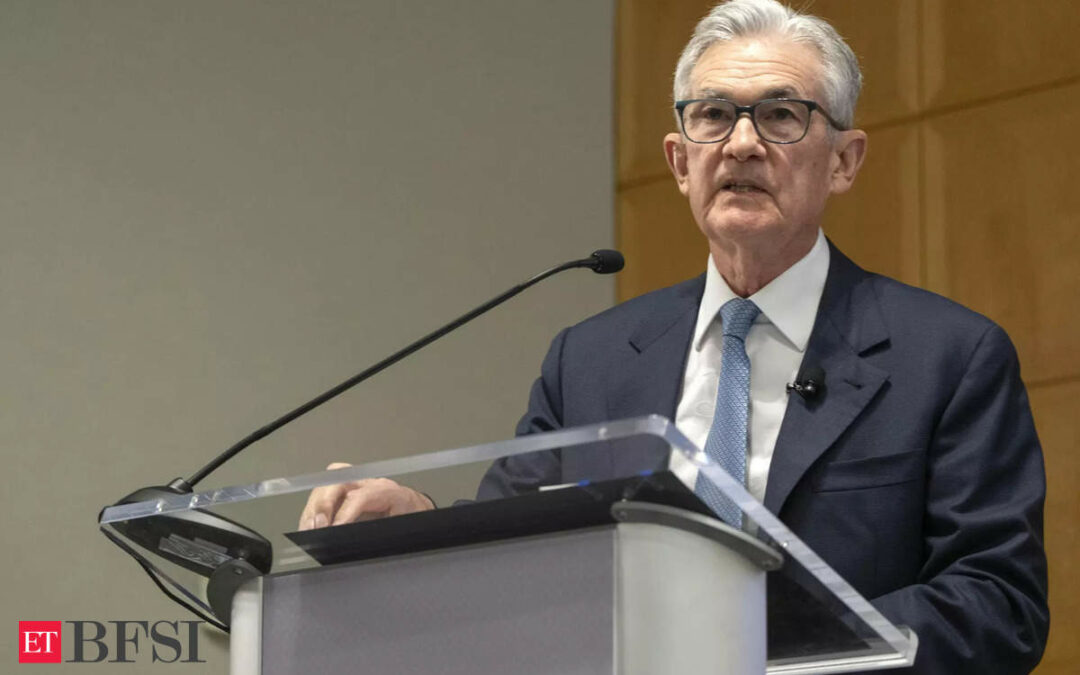US Federal Reserve chairman Jerome Powell on Thursday rattled financial markets worldwide by saying that the central bank was not yet confident that interest rates were at a sufficiently restrictive level to bring inflation to its 2% target. The statement, which leaves the door open for more Fed rate hikes, yanked five-year US bond yields above 5%, pushed the rupee to a record low versus the dollar, and sent stock markets tumbling. Here is an explainer on what is complicating the inflation outlook for the US and the likely impact on domestic markets.
Is the stronger economy challenging the inflation outlook?
The key challenge that has emerged for the US Fed is to rein in aggressive economic growth spurred by extraordinary fiscal stimulus in the world’s largest economy during the Covid crisis. Central banks tackle high inflation by hiking interest rates, thus raising the cost of capital and reducing aggregate demand in the economy. The Fed has raised interest rates by a whopping 525 basis points to a 22-year high over the past year-and-a-half, but key US economic growth metrics remain firm due to strong consumer activity. US CPI data was at 3.7% in September versus the Fed’s 2% target. With US GDP expanding at a higher-than-expected 4.9% annually in July-September, gone are the predictions of a ‘hard landing’ or a recession which might have prompted the Fed to cut interest rates. Many economists now expect US growth to ease, but remain in the positive territory throughout 2024, pushing hopes of Fed rate cuts further in the distance.What is the role of wage increases in the US?
A factor that has contributed to US inflation is tightness in the country’s labour markets caused by new dynamics in the workforce in the high-inflation post-Covid era. Developments suggest that wage inflation, which could then spill over into general inflation, could be a worry for the Fed. Latest US data showed that the number of new claims for government unemployment benefits fell, suggesting lower layoffs even as the labour market remains relatively tight. Recent union strikes aimed at negotiating higher wages display the shifts taking place in the economy. Last month, the Financial Times reported that the United Auto Workers Union and auto giant Ford had reached a potential deal to raise member wages by 25% over four years. Earlier in the year, private sector retail giant Walmart raised its minimum hourly wage while just hours ago, major Hollywood studios and unions agreed to the highest minimum wage increase in four decades, reports said.What’s keeping US bond yields high?
The US five-year bond yield rose past what is considered the psychologically significant level of 5% after Powell’s comments, bringing to the fore concerns over stock market valuations in the face of rising government bond yields. The rate at which the government issues bonds represents the ‘risk-free’ rate of borrowing in the economy. Firms which raise funds through bonds pay a rate—or spread—that is higher than the government. Moreover, equity valuations are based on bond yields. Rate hikes by the central bank push up government bond yields. The US 10-year bond yield, which has climbed more than 100 basis points since January, has been hovering around 16-year highs over the past few months. Apart from the fear of more rate hikes, structural factors such as a huge increase in US bond supply suggest that the country’s bond yields will remain high.
How do emerging market flows get affected?
Typically, higher US interest rates spark a migration of global funds from emerging markets to the higher returns in the world’s largest economy. India saw record overseas outflows of $17.94 billion from stocks and bonds in 2022, the year that the Fed started raising rates. While FPI flows are positive in the current calendar year, with investment worth $15.8 billion so far in the year, overseas players have been selling stocks for the past three months—with sales worth $5.4 billion—amid the talk of higher US interest rates. The overseas investment outflows exert downward pressure on emerging market currencies versus the US dollar. While India’s resilient economic growth and market interventions by the RBI have resulted in the rupee experiencing much lower depreciation than most other Asian currencies, the local unit is currently near all-time lows.
Where could domestic rates go?
Many commentators, including Monetary Policy Committee member Ashima Goyal, have pointed out that India is not showing signs of a rural-driven wage price inflation spiral. India’s intermittent inflation surges in 2022 were broadly caused by Covid-led supply side disruptions, both global and local, and a jump in international commodity prices after the Ukraine War. In the current year, inflation hardened in July-September due to sudden spikes in some vegetable prices, which have cooled since then. The RBI, which raised the repo rate by 250 bps from May 2022 to February 2023, has kept rates unchanged since then and forecast inflation at 5.4% in FY24 versus its 4% target. However, with elections scheduled next year, increased government spending aimed at welfare programs could pose an inflation threat. Earlier this month, Prime Minister Narendra Modi said that the government would extend a free ration scheme for five years.









